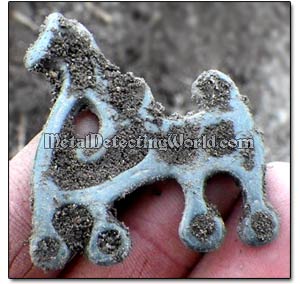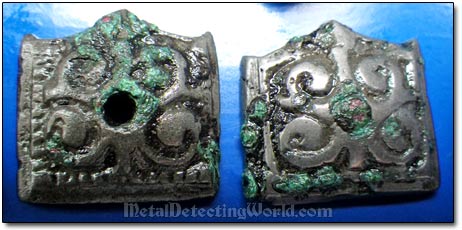My Search Programs for Minelab E-Trac and CTX 3030 Metal Detectors
Search Program #3 for RELIC HUNTING: AUDIO MENU, page 2
(...CONTINUED from Previous Page)
Audio Menu
(see details on page 4 of my 3-Level Search Program description)

THRESHOLD LEVEL - 17 (page 58 of the E-Trac Instruction Manual)
The THRESHOLD LEVEL is a little bit higher in this search program than in my other programs because I would like to hear the Threshold's nulling when the search coil is passed over rejected large silver and copper coins as well as some rejected nails (see my Discrimination pattern on page 5).
CTX 3030:
THRESHOLD LEVEL - 17 (page 23 of the CTX-3030 Instruction Manual)
VOLUME LIMIT - 15 (page 60 of the E-Trac Instruction Manual)
I do not recommend setting the VOLUME LIMIT at higher levels unless you do not use headphones, or your headphones have in-built volume controls which ARE USED for volume adjustment. A high VOLUME LIMIT setting might damage your hearing when an oversized target is detected.
If you use wireless headphones with your E-Trac, set the VOLUME LIMIT to 15. This improves the quality of wireless sound transmission (my article on "How To Make E-Trac Wireless" will be posted soon and announced in the "New Additions" (Visitor's Corner) section of this web site).
CTX 3030:
VOLUME LIMIT - 15 (page 24 of the CTX-3030 Instruction Manual)
VOLUME GAIN - 28 (page 61 of the E-Trac Instruction Manual)
Decrease the setting level to 27 or lower if the ground is HIGH-MINERALIZED.
CTX 3030:
VOLUME GAIN - 28 (page 23 of the CTX-3030 Instruction Manual)
Decrease the setting level to 27 or lower if the ground is HIGH-MINERALIZED.
RESPONSE - Long (page 62 of the E-Trac Instruction Manual)
I am just used to this mode. Try 'NORMAL' or 'SMOOTH' and see whichever you like better.
CTX 3030:
RESPONSE - Long (page 39 of the CTX-3030 Instruction Manual)
NUMBER OF TONES - 2 Tones (use the Tone ID sub-menu; page 64 of the E-Trac Instruction Manual)
The NUMBER OF TONES setting is not available in CTX-3030
Along with the FERROUS Sounds employed, the detector will respond to the partially masked nails with less iron falsing. Because the "audio" will be simple - low tone is for iron (also non-ferrous targets with their skewed FE values), and high tone for non-ferrous targets (also cast iron and steel-alloyed targets, and large iron objects), you will have to eyeball the screen to see the FE-CO read-outs of targets. This is why, if you are just starting to get into relic hunting, it is important to dig up many iron targets to learn their FE-CO values so that you can adjust the Discrimination pattern according to your requirements.
CTX-3030:
TONE PROFILE TYPE - 2 Tone FE (page 36 of the CTX-3030 Instruction Manual)
This Tone ID Profile is used with the E-Trac's Discrimination pattern shown on page 3, but the CTX 3030's tone bins can be resized (see details on page 10 of my tutorial - "How To Use Minelab XChange 2 for EDITING") and assigned different tone pitches according to your likes (see details on page 11 of the above-mentioned tutorial).

SOUNDS - Ferrous (page 65 of the E-Trac Instruction Manual)
The SOUNDS setting is not available in CTX-3030
CTX-3030:
TONE PROFILE TYPE - 2 Tone FE
This setting performs the combined function of two E-Trac's modes - NUMBER OF TONES and FERROUS SOUNDS.
VARIABILITY - n/a (page 67 of the E-Trac Instruction Manual)
This setting does not really play a big role unless you utilize the MULTI SOUNDS mode
VARIABILITY setting is not available in CTX-3030
TONE ID LIMITS - n/a (page 68 of the E-Trac Instruction Manual)
This setting is only available when the NUMBER OF TONES is set to MULTI.
The TONE ID LIMITS setting is not available in CTX-3030
TRESHOLD PITCH - 17 (page 69 of the E-Trac Instruction Manual)
CTX 3030:
TRESHOLD PITCH - 17 (page 24 of the CTX-3030 Instruction Manual)
Medieval Belt Studs
